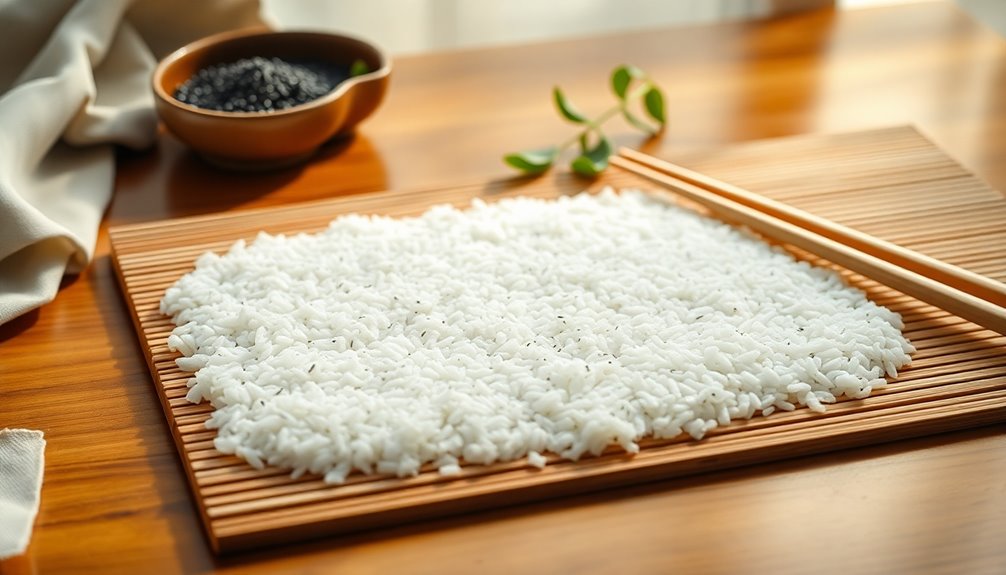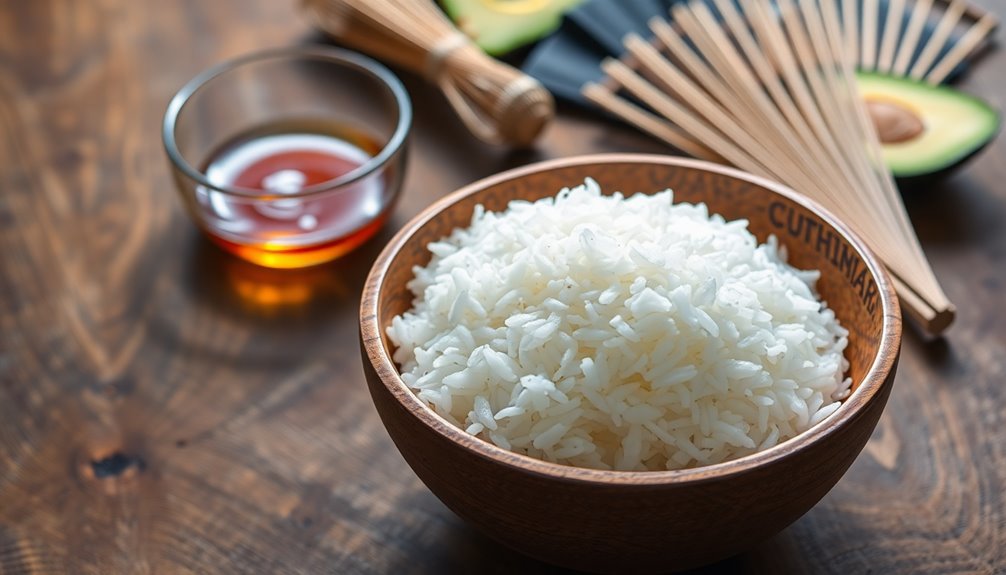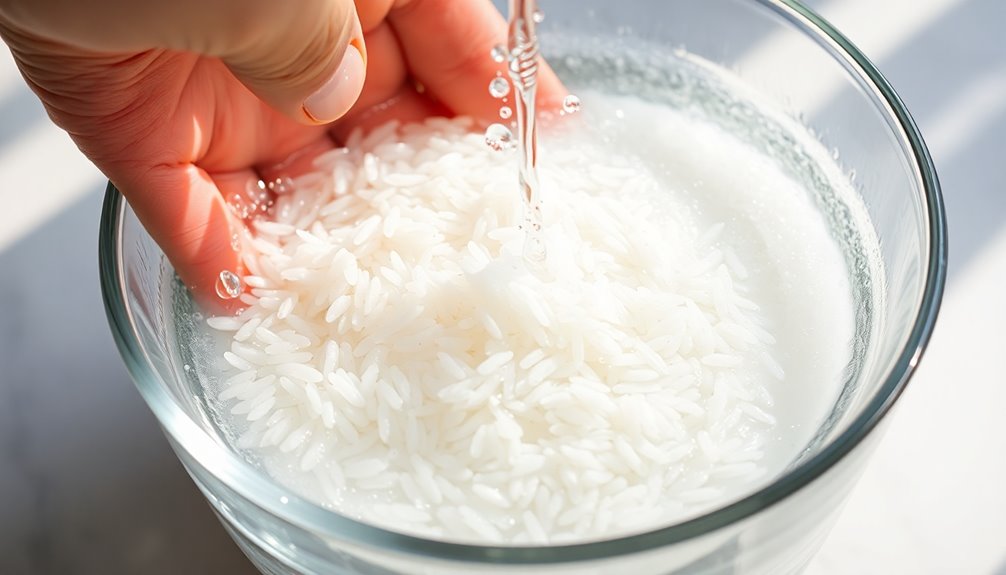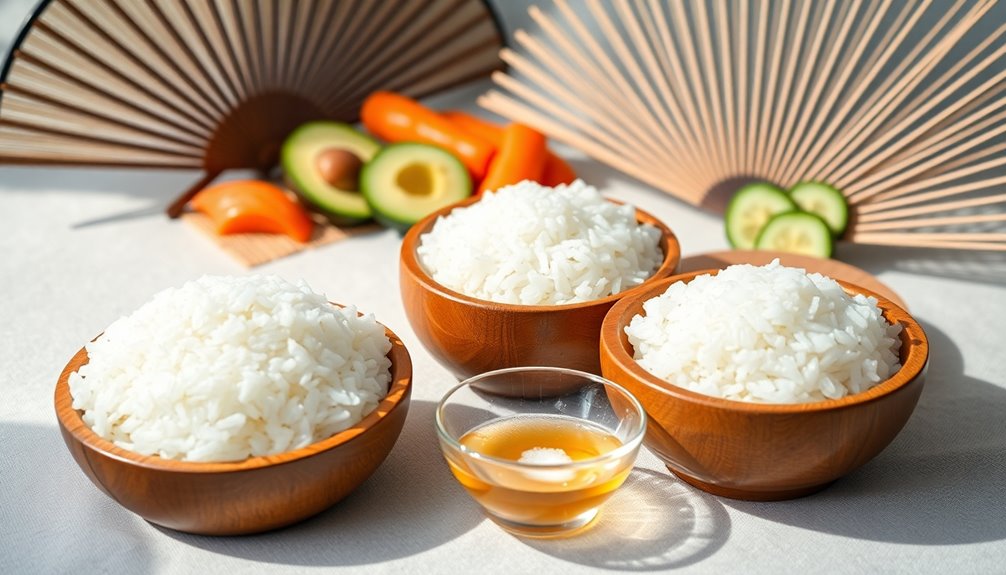When you think about sushi, the rice often takes center stage, playing a crucial role in the dish's overall experience. To achieve that perfect sticky texture and flavor, you'll want to start with Japanese short-grain rice. Rinsing and soaking are essential steps, but how you finish it off with the right vinegar mixture can make all the difference. Once you've got that down, you might wonder how this simple component elevates the entire sushi experience. Let's explore the nuances that can truly transform your sushi rice into something remarkable.
Key Takeaways
- Rinse 2 cups of Japanese short-grain rice until the water runs clear to remove excess starch.
- Soak the rinsed rice for 30 minutes to enhance its stickiness before cooking.
- Cook the rice using a 1.2:1 water-to-rice ratio for 30-40 minutes, ensuring a tender texture.
- Season the warm rice by gently folding in a mixture of 1/3 cup rice vinegar, 2 tablespoons sugar, and 1 teaspoon salt.
- Allow the seasoned rice to cool to room temperature before using it for sushi or other dishes.
History

Sushi rice, or sushimeshi, has a fascinating history that dates back over 2,000 years to ancient Japan, where it was originally used to preserve fish through fermentation.
Over time, sushi rice evolved, especially during the Edo period (1603-1868), when seasoning with vinegar, sugar, and salt began enhancing flavor and preservation. This innovation coincided with the rise of Edomae-zushi in Tokyo, where sushi became a popular street food in the 19th century.
The sticky texture of sushi rice, crucial for forming sushi rolls and nigiri, comes from the high amylopectin content in short-grain Japanese rice, cultivated specifically for this purpose.
Today, sushi rice's quality is recognized globally, with regions like Northern California producing esteemed varieties.
Recipe

Sushi Rice Recipe
Sushi rice is the foundation of many delicious sushi dishes, providing the perfect balance of flavor and texture. Made with Japanese short-grain rice, this dish is known for its sticky consistency, which allows it to hold together beautifully when forming rolls or nigiri.
The key to achieving the ideal sushi rice lies in the rinsing, soaking, and seasoning process, which enhances its taste and texture, making it a staple in Japanese cuisine.
To prepare sushi rice, begin by carefully rinsing the rice to remove excess starch, ensuring a fluffy texture. After soaking the rice, it's cooked to create that perfect sticky consistency. The addition of sushi vinegar, made from rice vinegar, sugar, and salt, elevates the flavor profile, making the rice an essential component of sushi, poke bowls, and more.
Ingredients:
- 2 cups Japanese short-grain rice
- 2.4 cups water (1:1.2 rice-to-water ratio)
- 1/3 cup rice vinegar
- 2 tablespoons sugar
- 1 teaspoon salt
Instructions:
Begin by rinsing the 2 cups of Japanese short-grain rice under cold water until the water runs clear.
Soak the rinsed rice in water for 30 minutes to enhance its texture.
After soaking, drain the rice and combine it with 2.4 cups of water in a rice cooker or pot. Bring to a boil, then reduce the heat and cover, cooking for about 15 minutes until the rice is tender and water is absorbed.
While the rice is cooking, prepare the sushi vinegar by gently heating 1/3 cup of rice vinegar, 2 tablespoons of sugar, and 1 teaspoon of salt until dissolved, then allow it to cool.
Once the rice is done, transfer it to a wooden hangiri or a large bowl and gently fold in the sushi vinegar mixture while fanning the rice to cool it down and achieve the desired sticky texture.
Extra Tips:
To ensure your sushi rice reaches the perfect consistency, avoid overcooking or undercooking it.
Using a wooden bowl or hangiri for mixing helps absorb excess moisture while cooling, enhancing the rice's texture.
Additionally, consider using a fan while folding in the vinegar mixture, as this will help to cool the rice quickly and give it a glossy finish.
Lastly, allow the sushi rice to cool to room temperature before using it in your sushi rolls or other dishes for optimal flavor and shape.
Cooking Steps

To get started on making perfect sushi rice, you'll want to rinse the rice until the water runs clear, removing excess starch.
After soaking it for 30 minutes, cook the rice in a steamer for the best texture.
Finally, mix in the vinegar and fluff the rice with a fork to achieve that ideal stickiness.
Step 1. Rinse Rice Until Water Runs Clear

Rinsing the rice is a vital step in preparing sushi rice, as it ensures the perfect texture for your rolls.
To rinse sushi rice, place it in a fine-mesh sieve or bowl and run cold water over it. You'll want to rinse it 3-5 times until the water runs clear. This process helps remove excess starch, which prevents overly sticky rice and allows you to achieve the desired texture.
Proper rinsing results in a fluffier final product, enhancing your sushi-making experience. After rinsing, let the rice drain well, ensuring consistent results.
Step 2. Soak Rice for 30 Minutes

After you've rinsed your sushi rice, soaking it for at least 30 minutes is crucial for achieving the perfect texture. This soaking period allows the grains to absorb water, which enhances their stickiness during cooking.
By rinsing the rice under cold water until it runs clear, you've already removed excess starch, but soaking helps activate the remaining starches that make the grains adhere better. If you're in colder weather, consider soaking for up to an hour.
Once the time's up, drain the rice thoroughly to prevent excess moisture, which can lead to mushiness. This essential step ensures even cooking and a delightful texture in your finished sushi rice. Enjoy the process!
Step 3. Cook Rice in Steamer

Once you've soaked the rice, it's time to cook it in a steamer.
Start by rinsing 400g of short-grain white rice under cold water until it runs clear.
Combine the soaked rice with water using a rice ratio of 1.2:1, which is about 480ml of water for your 400g of rice.
Place the mixture in your steamer and cover it tightly to maintain steam during cooking.
Steam the rice for 30-40 minutes, checking occasionally for doneness. You want the rice tender but not mushy to achieve the perfect texture.
After cooking, let it rest for 10-15 minutes before transferring it to a wooden hangiri or bowl, where you'll later add your sushi vinegar for seasoning.
Step 4. Mix Vinegar Into Rice

To perfectly season your sushi rice, start by transferring the warm rice to a non-reactive bowl or a wooden hangiri.
Prepare your sushi vinegar by combining rice vinegar, sugar, and salt in a small saucepan, gently heating until dissolved.
Once the rice is warm but not steaming, slowly drizzle the vinegar mixture over it.
Grab a rice paddle and gently fold the vinegar into the rice using a cutting motion. This technique helps maintain the integrity of the grains while ensuring even seasoning.
To enhance texture and shine, fan the rice as you mix, cooling it down and allowing for proper absorption of the vinegar mixture.
Your sushi rice is now perfectly seasoned and ready for rolling!
Step 5. Fluff Rice With a Fork

Having seasoned your sushi rice, the next step is to fluff it for the perfect texture.
First, allow the rice to rest covered for 10-15 minutes to achieve the desired consistency. Using a wooden paddle or a fork, gently fluff the warm rice, employing a cutting and folding motion. This method helps maintain the stickiness essential for sushi, preventing the grains from breaking.
If you're using a hangiri, move the rice in a circular motion while incorporating the vinegar mixture to enhance flavor and texture.
Final Thoughts

While preparing sushi rice might seem daunting at first, mastering the technique can significantly enhance your sushi experience.
The key to achieving perfect sushi rice lies in the careful balance of the water-to-rice ratio, typically around 1:1.2, ensuring sticky rice that's not mushy.
Once the rice is cooked, mix it gently with seasoned vinegar—comprised of rice vinegar, sugar, and salt mixed—allowing the flavors to permeate without mashing the grains.
Cooling the rice in a wooden bowl and fanning it helps achieve the right texture.
If you have leftovers, store the cooked rice in an airtight container in the refrigerator, and remember to reheat gently with a splash of water to maintain moisture.
Enjoy your sushi-making journey!










